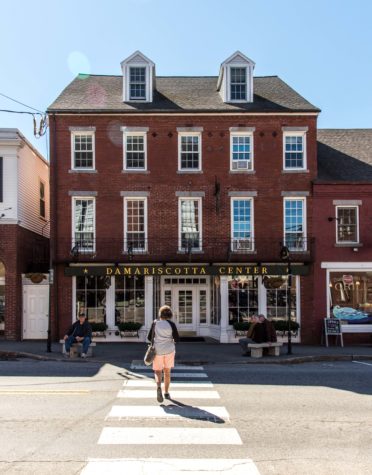The Damariscotta Region
Quaint towns and coastal scenery follow an oyster-rich river to the sea
Twelve miles from where the Damariscotta River meets the sea, the town of Damariscotta is the gateway to a. region rich in history and significant to Maine’s marine ecosystem. The word damariscotta is a rough approximation of an Algonquian word meaning “place of many fish,” a reference to the thousands of tiny alewives that annually travel upstream from the river into Great Salt Bay, and then spawn in freshwater Damariscotta Lake. Two hundred years ago, a fish ladder (now the country’s oldest) was built to enable the alewives to bypass the mill structures that separated the bay from the lake. Brined and smoked, the fish have their fans at the Alewives Festival, held every Memorial Day weekend, but far more popular are the region’s oysters, prized across the country for the flavor imparted by the cold, clean water in which they grow. In fact, the historic Whaleback and Glidden shell middens (large mounds) show that oysters have been enjoyed here for 2,200 years. Modern oyster farming began in the 1980s, and according to the Damariscotta River Association 80 percent of Maine’s oysters are grown in the river and its estuaries.
“Sample a variety from different farms,” suggests Michelle Phelps, an area notice and a principle at Phelps Architects, which has offices in Damariscotta and Portland. One of her favorite raw bars is at Schooner Landing, right on the river in Damariscotta, which offers free oysters and live music on summer Fridays. Other local standouts include Damariscotta River Grill, King Eider’s Pub, and Newcastle Publick House—all in town—or, farther down the peninsula, Shaw’s Fish and Lobster Wharf in New Harbor, the Contented Sole in Pemaquid, and Coveside Restaurant in Christmas Cove. “Another unique adventure is taking a sunset cruise with Damariscotta River Cruises to see oyster farms, with cocktails and oysters in hand,” says Phelps.
Downtown Damariscotta also boasts a vibrant mix of businesses, including two locations of Maine’s iconic Renys department store, a movie theater, a butcher shop, an excellent library, and the Stable Gallery, worth a visit for the Victorian architecture of the old stable as well as their noteworthy art. Find more examples of exemplary architecture in the classic homes along Glidden Street, just across the river in Newcastle. At the other end of town, Bristol Road is also lined with beautiful old properties, several of which house galleries and fine antique shops.
Like many Mainers, Phelps is accustomed to summer visitors and has a time-tested itinerary for newcomers. “We’ll pick up a picnic lunch from S. Fernald’s Country Store in Damariscotta or C.E. Reilly and Son in New Harbor, and head for the end of the peninsula to see Pemaquid Point Lighthouse, Fort William Henry, and Pemaquid Beach,” she says. “The lighthouse is a must-see with the dramatic metamorphic rock formations, tide pools, and waves crashing on the point, and the view includes lobster boat activity, sailboats cruising by, and sightings of bald eagles, ospreys, ducks, and seals.” The long, crescent-shaped beach, which has restrooms, changing facilities, a snack bar, and calm water for swimming, is popular with families. For more of an adventure, Phelps suggests taking the Hardy Boat out of New Harbor for a day trip to the island of Monhegan. “It’s my personal favorite and worth the trek to see seals, birds, and ocean scenery. Once on the island you can walk to explore several island trails, visit galleries, and stop in for a brew at Monhegan Brewing Company, before taking the boat back to the mainland.”
Phelps also recommends a couple of local hikes. The trails at Dodge Point meander down through the woods to the shore of the Damariscotta River, and the jagged shore at Cresgy’s Point in Pemaquid is a “secret” spot for shell and sea glass hunting. “Be sure to wear the right footgear,” Phelps cautions. Kayaking on Damariscotta Lake is another summertime favorite. “You can launch at the public dock, and there are several little islands in the lake to explore; one in particular is complete with a rope swing for swimming, and you can also camp and pick blueberries,” Phelps says. “Kayaks can be rented from Midcoast Kayak in Damariscotta, an easy option for exploring the Damariscotta River and seeing the oyster farms.” For everyone from explorers to shoppers, food fans to beachcombers, this vibrant region offers an abundance of what residents and visitors alike love about Maine.









